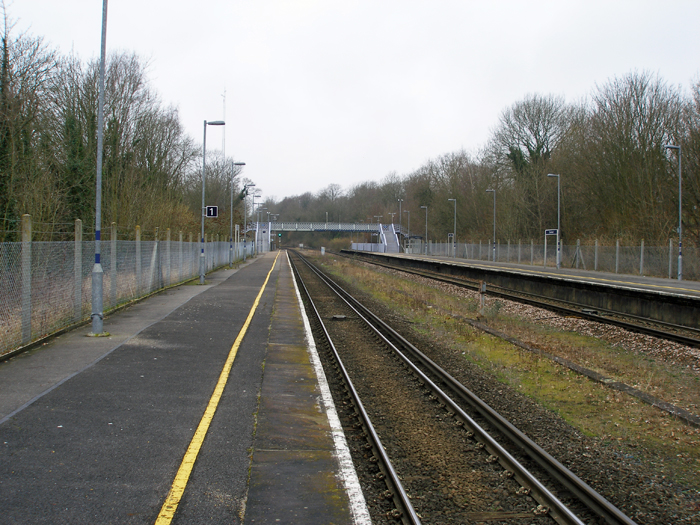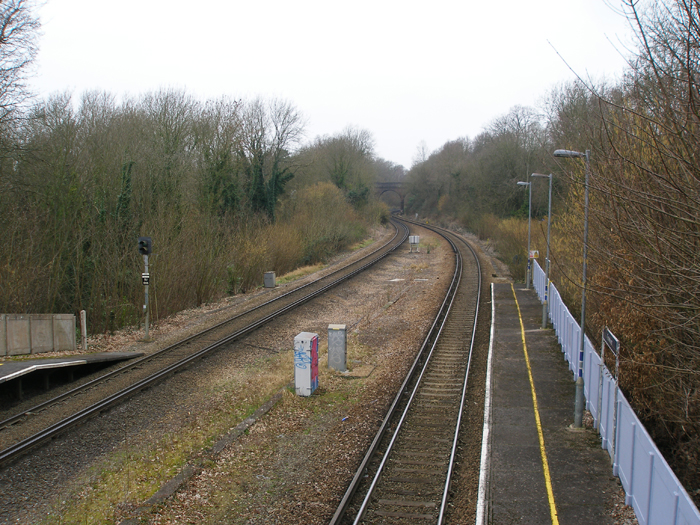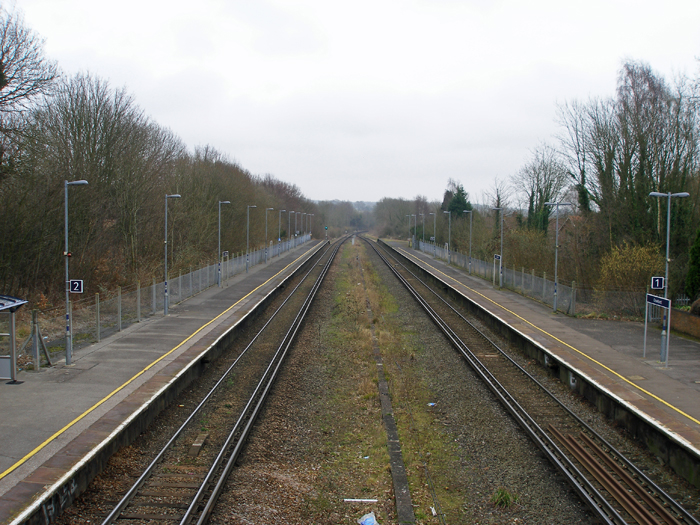
Since Crowhurst was a modern, well-laid out station, alterations under the Southern Railway (SR) were merely superficial. In addition to the appearance of "Target" name signs, concrete lampposts were installed along both platforms, these comprising metal brackets supporting hexagonal lampshades. The latter were also fitted to those lights hanging underneath the canopies.
Electrification of the route from Sevenoaks (which had been reached by third rail in 1935) to Hastings via Tunbridge Wells, including the Bexhill West branch, had been earmarked for January 1939. However, the SR opted not to pursue this scheme after all, primarily because it would involve the expense of specially-built electric rolling stock capable of fitting through the narrow tunnels south of Tonbridge. The alternative would have been to widen the tunnels, a substantial and costly undertaking which made the retention of steam traction more attractive. Plus, Hastings had been reachable from London by 660-volts DC third rail since 5th July 1935, when public electric services commenced over the route via Lewes. Electrification of the line via Tunbridge Wells and the Bexhill West branch surfaced again in November 1946, when it was approved as part of a larger SR project. However, this was overtaken by nationalisation and the proposals dropped.
Under British Railways Crowhurst No. 1 signal box, situated at the London end of the layout, was closed in 1951, control being assumed by the remaining 87-lever No. 2 cabin to the south east. In 1957, diesel-electric traction was introduced on the route in the form of the "Hastings" 6S, 6L, and 6B fleet, which ran alongside steam services in this year. These units were built to a narrow width to fit through the restricted tunnel bores on the route, each being, as the class code implies, six vehicles long. The units would run in multiples of two at peak times, so the platforms at Crowhurst were lengthened in 1957 at their London ends with Exmouth Junction-manufactured prefabricated concrete, to accept twelve vehicle formations. The full diesel timetable from Charing Cross to Hastings via Tunbridge Wells came into use on 9th June 1958.
On the Bexhill branch side of things, the shuttle service to the terminus from Crowhurst had also completely gone over to diesel electric traction in 1958, the then new Hampshire/Berkshire units monopolising workings. The diesel reign transpired to be a short one, for the branch line's closure was sanctioned in May 1964 and actioned on 14th of the following month. After 62-years of existence, during which it was closed for over two years due to wartime economies, the Bexhill branch was no more. It is perhaps surprising that Crowhurst did not close with it, given that most of the station's traffic even at that time must have been directly linked to the branch line. The population of the sleepy village was still comfortably under 1000, but nevertheless, the station stumbled on. However, all was not rosy ahead.
Public goods traffic had earlier ceased on 5th June 1961, but a single private siding still existed. Appropriately called "Crowhurst Siding", this was situated about 150-yards south east of the junction, was London-facing and on the "up" side of the line. Protected by a gate, the siding was formally closed on 2nd April 1962. However, the withdrawal of goods traffic, combined with the branch line's closure, did not see immediate rationalisation of the track layout. This eventually came in 1971, when the original No. 2 signal box was closed and the little-used centre tracks and redundant bay lines lifted. The main running lines were slewed outwards to the platforms, and what was once the most extensive layout on the route had been reduced to nothing more than a basic two-track affair. Worse was yet to come, however, and in late 1984 the station buildings and canopies on both platforms were demolished, a tragic outcome for what was once a very attractive station. Service modernisation saw a full electric timetable come into effect on 12th May 1986, but as far as Crowhurst station was concerned, the damage was done.
The lattice footbridge and the diminutive "up" side lamp room, the latter now a source of tickets, were given a stay of execution, and today remain as the only relics from 1902. However, all is not lost for the budding railway historian and he/she can still find traces of Crowhurst's architecture at other stations which retain structures from a bygone era. The same canopy design, complete with ridge-and-furrow roof and clover-patterned valance, can be observed on platform 1 at Maidstone West. Similarly, the design of Crowhurst's main "up" side building can readily be seen in those structures at Folkestone West, albeit in red rather than yellow brick.

A London-bound view presents a desolate scene. The former "up" bay has mostly disappeared underneath a line of trees which shield a later housing development. The "down" bay has similarly returned to nature. © David Glasspool

When the layout was rationalised, the running lines were slewed outwards to meet the platforms, as shown in this London-bound view from the footbridge. The "down" main (right) now runs partially over the former site of "No. 1" signal box, closed in 1951. © David Glasspool

A Hastings-bound view from the footbridge presents an unloved scene, compared to the halcyon days of four-tracks, branch line trains to Bexhill, and proper station canopies. Fencing off the former bays has reduced the platform width on either side by about half. © David Glasspool
Return to the Kent Rail Homepage or alternatively, check for Updates.
Website & Copyright information - Links - Contact the Webmaster